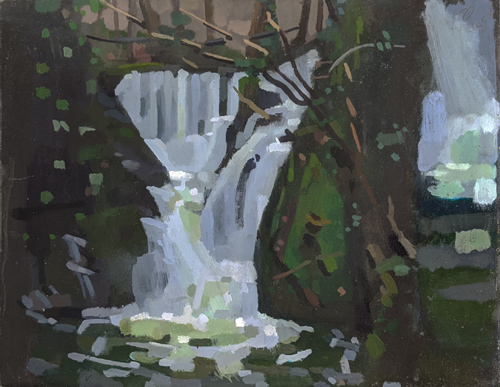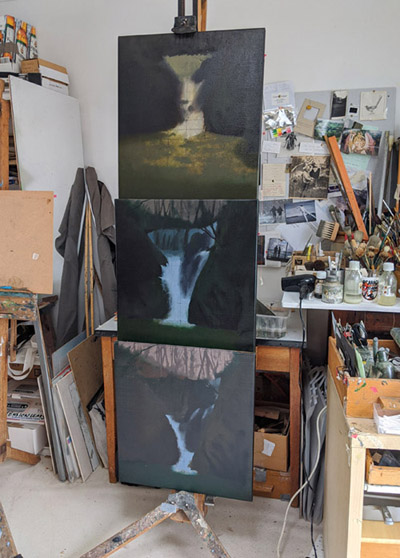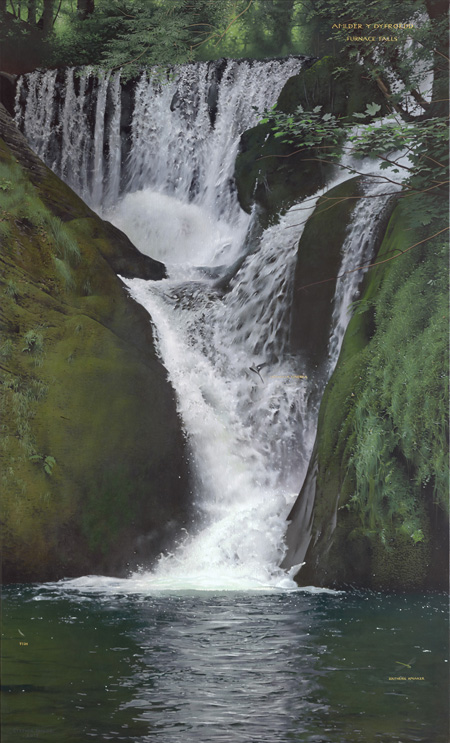waterfall

I had found a nature condenser: a stone and water chamber filled with noise, plants and animals. Updraughts buffeted leaves, branches and insects. Protean, the water changed colour, texture and speed and direction. And when the sun fell on all this the scene fragmented in ways that defied imagination.
I settled down and made an oil study and later, back in Essex, I began a big canvas only to put it aside to make paintings of a local field. But I didn't forget Furnace Falls: its distinctive shape combined with that first impression of endless richness and it seemed to become a kind of symbol or emblem.
Painting is a way of making contact with nature first hand - think of Cézanne or Constable. In this tradition there is an assumption that we don't know what things look like and that painting offers a unique way of finding out. Its empirical, exploratory and exciting.
Compared to an object on a table, a waterfall is almost impossible to see. At a distance waterfalls often have a distinctive shape, but close to they all look chaotic. I think this combination of stability and instability is part of their facination. It's as though they are telling you that you can and can't see them, that their permanence is true and not true.
The images in Waterfall show how one spot can yeild many different visions of water. You don't have to travel to see variety in nature, you just have to learn to look at things. The paintings in this group exploit different sources - oil studies, drawings, notes and photos, with digital analysis and re-organisation in the studio, along with emotions recollected in tranquility.
WORK IN PROGRESS
click images
SUMMER POSTCARD 1
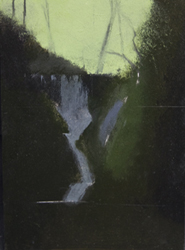
SUMMER POSTCARD 2
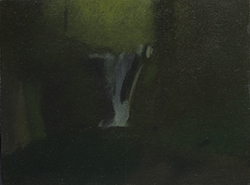
FINISHED PAINTINGS
furnace falls : amlder y dyfroedd
WATERFALLS ON THE FENS : Image and Reality
The photo of Niagra falls was realistic, but everything else about the card told me that it was not. I was reminded in a fresh way that even the most realistic image is a thing of the imagination. This shifted the way I saw my waterfall paintings. I was still drawn into their reality, but at the same time it became easier to see them as unreal. It seemed a just small step to see my paintings as pictures of an imagined place - like pictures arriving by post.
Both post card and paintings brought to mind imagined maps. In the case of Furnace, the falls had become a location on my mental map of England and Wales, a map with compass points, a simple geography and huge gaps, scattered with places I knew.
Receiving a postcard is also a form of participating in a shared mental map: - now a global commonplace with phone photos and videos creating billions of different shared maps of almost everywhere in the world. But this is to run ahead.
To focus my own thoughts I began to collect old postcards of Furnace falls. And as I read the messages on them I felt things in common with the people who'd sent these cards from Furnace all through the twentieth century. I now have a large collection, and am making some card display cabinets of a kind once found around Wales to show tourists the local sights. I remember them from childhood, and the new cabinets will be shown with the paintings as part of Waterfall:
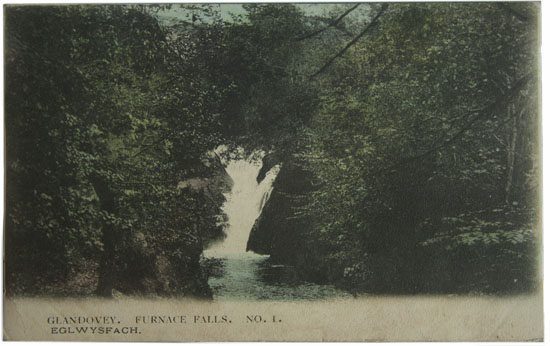

This is one posted in 1906 in Eglwysfach, the village by the fall where the sender lived, at Ty-mawr - literally 'big house'. It was addresed to The Liverpool Royal Infirmary with a message in Welsh* which reads
It was good to hear from you and to know you are improving and have got through the operation very sucessfully. You will be as strong as a horse again, like before. After sending this I'm going to Festiniog today or tomorrow.
Jim.
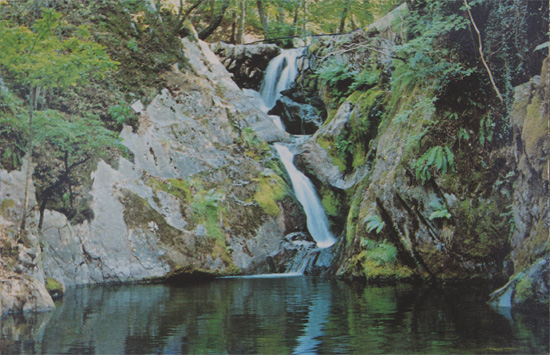

By permission of Llyfrgell Genedlaethol Cymru / National Library of Wales
NATURAL IMAGES
We are still trying to read the book of nature.
How we imagine waterfalls concerns us all.
WELSH TITLES

The Welsh titles for these paintings come from conversations with Gerald Morgan. I often heard Welsh as I grew up but have no Welsh myself; however Gerald is a Welsh speaker and scholar.
* Souvenir spoon cameo designed for Sampson Souvenirs, now Judge Sampson Ltd. With thanks to Non and John Griffiths of Eglwysfach, who commissioned and sold this souvenir.
* Post card translation by William Troughton, Visual Images Librarian, National Library of Wales.
* For a contemporary discussion of local language and nature, see Robert MacFarlane's book Landmarks.
Special thanks to Elfed Wyn Jones and Anwyn for sound recordings of Welsh picture titles.





